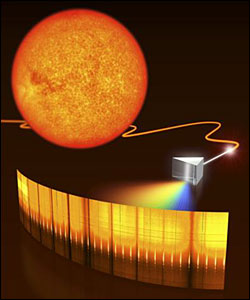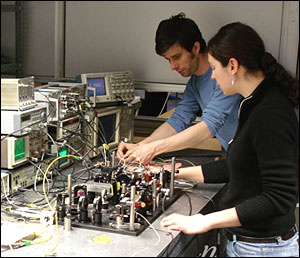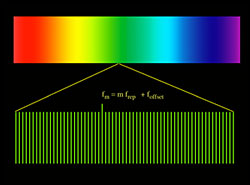
Laser Comb is Ultraprecise
A laser frequency comb, a new calibration technique that combines the incredible precision of an atomic clock with the sharp spectral features of laser light, has been used at a solar telescope to measure the sun's spectrum in infrared light. Such precise spectrographs are needed if astronomers are to accurately measure our expanding universe.
The technique combines astronomy and quantum optics in a collaboration between researchers at the European Southern Observatory (ESO) and the Max Planck Institute for Quantum Optics (MPQ). It uses ultrashort pulses of laser light to create a frequency comb -- just the kind of precise ruler needed to calibrate a spectrograph.

Artist's impression of the laser comb developed for astronomy. Such a laser comb is necessary to act as a "ruler" for calibrating the new, extremely precise spectrographs needed in the future to search for Earth-like planets or measure the expansion of the universe. To test this laser comb, a team of scientists went to the telescope and analysed the light coming from the sun. That light was coupled to an optical fiber that guides it to a spectrograph (prism) in order to resolve its spectral lines. The spectral lines from the sun appear as dark bands because they represent the wavelengths of light that has been absorbed by the sun's photosphere as it emerges from deeper within the star. Superimposed are many short, bright (white) spectral lines of the laser frequency comb that serve for calibration. (Image: copyright ©ESO)
A frequency comb is a special laser that emits extremely short pulses of light only femtoseconds long (i.e. thousandths of a millionth millionth of a second) in millions of extremely well-defined colors. The frequencies (or wavelengths) defining all these colors are controlled by an atomic clock, so they are extremely accurate. They are also spaced equally with respect to each other, like the markings on a ruler.
"It looks as if we are on the way to fulfill one of astronomers' dreams," said team member Theodor Hänsch, director of MPQ in Germany. Hänsch, together with John Hall, was awarded the 2005 Nobel Prize in Physics for work including the frequency comb technique.
The colors emitted or absorbed by heavenly bodies provide astronomers with information about the speeds at which the stars, galaxies and other astrophysical objects are moving via the Doppler effect -- the bunching up or stretching out of light waves as they emerge from (or travel through) objects and gas clouds and then move through the universe.
Astronomers use instruments called spectrographs to spread the light from celestial objects into its component colors, or frequencies, in the same way water droplets create a rainbow from sunlight. They can then measure the velocities of stars, galaxies and quasars, search for planets around other stars, or study the expansion of the universe.
A spectrograph must be accurately calibrated so that the frequencies of light can be correctly measured. This is similar to how we need accurate rulers to measure lengths correctly; a laser provides a sort of ruler for measuring colors rather than distances, with an extremely accurate and fine grid.

Tilo Steinmetz (left) and Constanza Araujo-Hauck (right) align the frequency comb at the Vacuum Tower Telescope solar telescope at Tenerife. (Photo: Constanza Araujo-Hauck)
New, extremely precise spectrographs will be needed in experiments planned for the future European Extremely Large Telescope (E-ELT), which is being designed by ESO. These new spectrographs will need to be calibrated with even more accurate rulers. In fact, they must be accurate to about one part in 30 billion -- a feat equivalent to accurately measuring the circumference of the Earth to within a millimeter.
"We'll need something beyond what current technology can offer, and that's where the laser frequency comb comes in. It is worth recalling that the kind of precision required, 1 cm/s, corresponds, on the focal plane of a typical high-resolution spectrograph, to a shift of a few tenths of a nanometer, that is, the size of some molecules," said PhD student and team member Constanza Araujo-Hauck of ESO.
After successful tests in the MPQ laboratory in 2007, the team successfully tested a prototype device using the laser comb at the VTT (Vacuum Tower Telescope) solar telescope in Tenerife, on March 8, 2008, measuring the spectrum of the sun in infrared light. The results were impressive, and the technique promises to achieve the accuracy needed to study these big astronomical questions, team members said.
"In our tests in Tenerife, we have already achieved beyond state-of-the-art accuracy. Now we are going to make the system more versatile, and develop it even further," said team member Tilo Steinmetz from Menlo Systems GmbH, a spinoff company from the Max Planck Institute founded to commercialize the technique.
Having tested the frequency comb technique on a solar telescope, a new version of the system is now being built for the HARPS planet-finder instrument on ESO's 3.6-meter telescope at La Silla in Chile, before being considered for future generations of instruments.
One ambitious project called CODEX, to be realized with the E-ELT, aims to measure the recently discovered acceleration of the universe directly, by following the velocities of distant galaxies and quasars over a 20-year period. This would let astronomers test Einstein's general relativity and the nature of dark energy.

The frequency comb, which is the light from a pulsed femtosecond laser, consists of many colors that are only revealed when observed with a high-resolution spectrometer, such as those typically used in astronomical telescopes. The spectral lines of the comb can be stabilized to the frequency given in the graph using an atomic clock. (Image: Theodor Hänsch)
"We have to measure the movement of these distant galaxies to a few centimeters per second, and follow this over decades. These speeds are barely faster than a snail's pace, and the laser frequency comb is absolutely crucial for this," said team member Antonio Manescau of ESO.
Astronomers also use spectrographs to hunt for planets around other stars, by watching for subtle movements of the star as the planet orbits it. To be detected with current technology, these planets must be relatively massive or close to the star, compared to Earth. A more precise spectrograph will let astronomers find planets, with characteristics similar to Earth's.
Currently, the system works only in infrared light. In the future, the astronomers want to broaden the comb light to cover more colors, or even the entire optical spectrum from ultraviolet to infrared. They would also like to get the same amount of light at all colors for the system.
The work is published in this week's issue of Science.
For more information, visit: www.eso.org
Published: September 2008